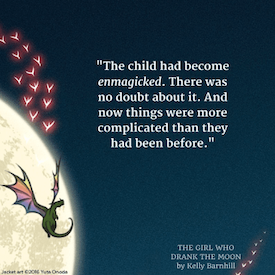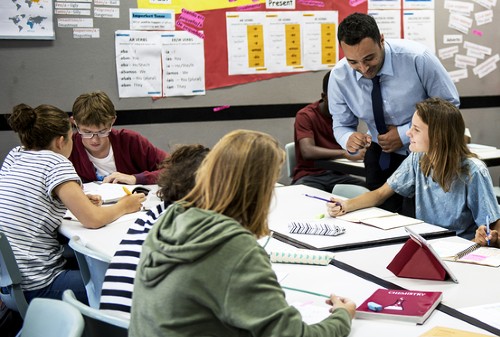Using Talk about Texts to Grow Conversation Skills

“How did you communicate with Dad when you were dating and texting wasn’t invented yet?” One of our children asked this question recently. (!!!)
“We talked to each other over the phone or face to face,” was my response after a few you-won’t-believe-this giggles. “We had live conversations.”
My oh my, how the medium for conversation has changed over the years. Now most of us are accustomed to communicating in bits and pieces – tweets, snaps, emojis. Like our students, we text multiple times a day. Brevity is often the goal, with gifs and digital images used to relay emotions.
But, dare I say it, lingering within a face-to-face conversation is still essential. Meaningful conversation unites us, allows for self-expression, and helps us to examine different points of view. Arguably, we become better people when we talk with each other.
What better place to build the essential skills of speaking and listening than in conversations about texts? Here we have the opportunity to talk in depth, hear others’ points of view, and evolve as thinkers, readers, and talkers. As teachers we provide the tools to help our students use their voices, to support their ideas with evidence, and to speak with conviction.
Students grow by listening with an open mind and learning to respectfully disagree – to provide evidence to support their thinking and to challenge ideas. As we realize, and have experienced, it is often not that easy for digital natives to jump into flourishing face–to–face conversations.
Here are some of favorite ways my colleague Patty McGee and I nourish classroom talk.
We ask students to study conversation that happens in other places
One thing we love to do is take a video clip, show a bit of the clip, and ask students to notice the conversational moves of a productive conversation. We have an example of one here along with some guiding questions and possible discoveries students will make about the video clip.
(We like to start at minute 3:51 and end at minute 13:55.)
Guiding questions:
1. What is the person talking doing that makes what he is saying strong?
2. What are others doing? Not doing?
3. What are you noticing about conversation in this clip that you could also try in your conversations?
So many aspects of good conversation are exemplified in this clip. For example:
• The conversation starts with an open-ended question
• Participants share their own thinking
• There is a back and forth dialogue – participants push each other to expand upon their ideas
• There are numerous connections to participants’ own lives and experiences
• Panel members respectfully disagree: “couldn’t it also be that…? Might it be…?”
• Participants refer to research that was prepared prior to the conversation
• Members are respectful of each other and do not interrupt
Likewise, students can home in on places where the conversation falters, noting how to avoid some of the participants’ missteps.
Similar to a mentor text, a “mentor conversation” like this helps with goal setting and makes effective skills and strategies more tangible. Noticing elements of effective conversation encourages students to reflect upon their own dialogue.
We Use Talking Stems
Conversational strategies transfer from text to text, yes, and also into any subject area or context. These are universally beneficial skills. One of our favorite ways of building conversational strategies is to give some wording that students can draw upon in different situations.
When building on what others said:
✻ I agree, and I’d like to add…
✻ In addition to what you are saying…
When challenging an idea:
✻ I didn’t see it the same way… Instead I…
✻ While I see your point, I think…
When changing the subject:
✻ This brings something else to mind…
✻ I have also been thinking about…
The use of stems and prompts to identify areas for discussion at the beginning, middle and end of any text can help students to engage in meaningful conversation in whatever part of the book they are reading. So often students will say, “but I’m only in the beginning of the book – I don’t know what it’s really about yet.”
Providing simple, predictable prompts and stems can help students to begin and sustain their conversations at any point, in any text. For example:
Beginning (focus on characters, setting, problem, questions)
✻ The setting of this story is important because….
✻ I think this character may be____ because he/she says/thinks____________.
✻ I wonder whether this part of the text may be hinting at the problem. I’m noticing….this makes me think…
Middle (sort your jots to notice patterns/big ideas that are emerging)
✻ Some patterns I see in my jots are…. This makes me think….
✻ A big idea I’m deciding to follow is ______ because I’m noticing a pattern.
✻ Some of my initial thinking about character/setting/plot has changed because now I see…
End (pulling it all together)
✻ Now I’m realizing….
✻ This gives me the idea that…I
✻ An important lesson the character learns is….
✻ This author teaches us….
We Assume the Role of Conversation Coach
A coach in a soccer game stays on the sideline. They can give advice to the players in action but they are not permitted to play the game. This makes for stronger and more confident soccer players. When we take on the role of conversation coach, the same holds true.
Once strategies are introduced, step back, outside the circle, and let the conversation flow. It’s okay to note areas where students can lift the level of conversation, but it is important to recognize that your role in the actual conversation is minimal.
Here’s a real example. As fifth graders engaged in a book club chat about social issues, one conversation about Newbury winner The Girl Who Drank the Moon sounded like this:
Kristin: I think the witch is taking the children for the greater good, without realizing the consequences.
Leah: Yeah, but the people – they’re afraid.
Kristin: Yes, they’re scared. It says in the text, “we’ve taken steps, terrible steps…don’t make me say it ….we must make sure she cannot be seen.” People are afraid of the witch.
Leah: I think they’re scared because she takes young children. It’s hard for people to know how to feel.
Kristin: But she’s not taking them for spite – she’s taking them for the greater good. It says on page 31, “Xan, I must insist that you do not fall in love with your baby.” I think she actually likes kids and she wants to warn people to be careful.
Sophie: Yes, she doesn’t understand that there will be consequences. The witch is misunderstood. People think she’s mean, but she really likes children.

At this point, I suggested some of the talking stems for deepening conversation. Since they were still in the beginning of the story, we pulled out one of the talking stems for the beginning of the text:
I wonder whether this part of the text may be hinting at the problem. I’m noticing….this makes me think….
They decided to group their collective noticings. Using the prompt, students noticed that forces for good seemed to be at odds with forces of evil. This focus on good versus evil was enough to elevate their conversation to a bigger, universal idea. The “this makes me think…” prompt helped to push their thinking as they considered how often this dynamic plays out in the real world.
Additionally, they were able to connect what they saw in The Girl Who Drank the Moon to other books they had read (in this case, Harry Potter). Because they did this work themselves (after we stepped in for a bit of coaching and then stepped out), they are more likely to transfer this type of thinking to other books and to future conversations.
Each of these ideas for elevating talk can help students to incrementally grow their conversations. When used together, they are a powerful framework that can help students discover that meaningful conversations are closer and more accessible than they think.
Works Cited
“Are Competitive Sports Good for Children?” TRT World, trt.world/roundtable.
Clements, Katie,TC. Reading and Writing Project Saturday Reunion Lecture, 2018
Goldberg, Gravity, Staff Developer for Ramsey School District, 2017
Nancy Costanzo is a fifth-grade teacher in the Ramsey Public Schools in New Jersey. Her instructional approach has been greatly influenced by Gravity Goldberg, Pam Koutrakas, and staff developers from the Teachers College Reading and Writing Project.
Many authors and consultants have come to study in Nancy’s classroom to refine their instruction approaches in the humanities, including Patty McGee as she developed her work around feedback. Prior to entering the classroom, Nancy worked in pharmaceuticals – in sales and in curriculum development for global sales training. She tweets @NancyCostanzo2.






































